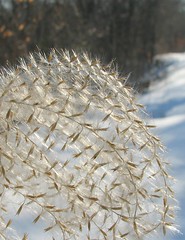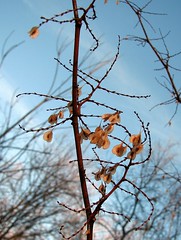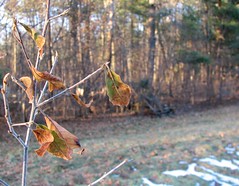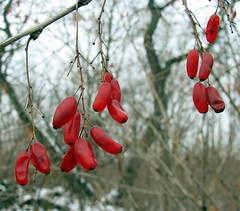The Center for Invasive Plant Management recently announced Requests for Proposals for their Research Grants. While proposals need to focus on plants that are problems in the Western U.S., the work can be done anywhere. The CIPM also announced funding available for their Cooperative Weed Management Area Grants. The deadlines for both programs are at the beginning of March.
Tuesday, January 31, 2006
Monday, January 30, 2006
There is seemingly no end to the innovations that come about while trying to control the coqui frogs (Eleutherdactylus coqui) that have invaded Hawaii. So far researchers have tried caffeine, citric acid, and hydrated lime. Now The Honolulu Advertiser is reporting that a collaboration between the University of Hawaii and an O'ahu nursery owner has led to the construction of a large chamber that blasts plants with heat and water. The steam cleaning is hot enough to kill most frogs but doesn't seem to harm the plants. The owner of the nursery is hoping the method can be fine-tuned to kill all frogs, allowing "guaranteed coqui-free plants" to be shipped off-island.
Sunday, January 29, 2006
This week in invasive species blogging, the ISW brings you a blog-of-a-blog (that's like friend-of-a-friend but better). Over at the Human Nature Nuggets blog you'll find a meaty one about "...which is more important to us—the benefits we are reaping as a result of these foreign species—or our comfort?" complete with a link to a post about grey squirrels from A View from England. Chew on that!
Bonus points to Human Nature Nuggets just for their cool, cool name.
Saturday, January 28, 2006
Miscanthus in Fruit I

Miscanthus in Fruit I
Originally uploaded by urtica.
I found this lone stem of Chinese silvergrass (Miscanthus sinensis) when I was walking along the Bruce Freeman Rail Trail in Framingham, MA. It will be interesting to revisit the site in the spring to see if this plant is the wild type form or an escaped cultivar.
Friday, January 27, 2006
Interesting story in the San Antonio Express-News about the feral pigs (Sus scrofa, also known as wild boars or feral hogs) running wild in Texas. While the pigs have been known for years as a bane to Texas agriculture, they've recently been making their way into the suburbs of San Antonio too. Residents are none too happy about it, and some are willing to pay hundreds of dollars to companies that will trap the pigs, hopefully before they have their way with the flower beds.
Bonus points to the Express-News for printing one seriously weird photo of a feral pig (dead presumably) sitting on top of a pit bull in a cage.
Thursday, January 26, 2006
Road Warriors
The U.S. government and the Pennsylvania Deptartment of Transportation have put together a unique educational outreach video that targets road maintenance crews. "Dangerous Travelers" tells workers where to seek help to learn about the weeds in their area and gives tips for thinking smart about invasive plants when disturbing the land. It was great to see the example of a crew that goes out and collect seeds and other native plant propagules *before* construction so that they can restore the disturbed land using the same native stock that was originally growing there.
I highly recommend this 26 minute video not only to anyone who works on a road crew, but also to all you land managers out there who are impacted by the work of those crews. There's plenty of good advice in there for everyone. Also, I really, really want my own boom-mounted brush mower :-).
Tip of the virtual hat to the folks on the APHIS listserver for posting about the video.
Wednesday, January 25, 2006
Back in 2004, the ISW reported that the emerald ash borer (Agrilus planipennis) had been discovered for the first time in the state of Indiana. Now the Indianapolis Star is reporting that a recently discovered infestation in the town of Carmel could be as much as seven years old. State officials think the EAB may have been introduced back in 1999, when landscapers received a shipment of ash trees from Michigan and planted them in the town. This means that the beetle is likely to have had several years' worth of a head start vs. Indiana's efforts to control its introduction and spread. Not good news for the state's ash trees.
Thanks to Bob C. for sending in a link to Indiana's EAB press release.
Tuesday, January 24, 2006
Alewife, good or bad, invasive or not? As reported by the Chicago Tribune, it may depend on how you look at it. Turns out the alewife (Alosa pseudoharengus) has been sustaining stocked populations of salmon in Lake Michigan, and those stocked populations have been sustaining a thriving sport fishery. The coho and chinook salmon (Oncorhynchus kisutch and O. tshawytscha, respectively) were first stocked in the lake in the 1960s as a way of controlling the non-native alewife, whose populations had grown out of control. Now the salmon have developed a taste for the alewife, and they've practically eaten their invasive food supply out of existence in the lake. The Michigan Department of Natural Resources is responding by cutting back on the number of salmon that will be stocked in the spring, in order to give the alewife a chance to recover.
Monday, January 23, 2006
According to this press release published by SooToday.com, the Ontario Ministry of Natural Resources is none too happy that the European rudd (Scardinius erythrophthalmus) has been found in Lake Wilcox (.pdf). The rudd, typically used as a bait fish, has been seen in the wild around the Great Lakes region since the 1990s. However, it is illegal to use as bait in Canada (and so they're blaming it on the Americans, hmph). This is the first recorded sighting of the species in an inland body of water in Ontario.
Sunday, January 22, 2006
This week the ISW finds itself, in more ways than one, over at Walking the Berkshires. Stop by yourself to read "Living with Loosestrife," a discussion of how to manage purple loosestrife and phragmites invaded habitats, with a little bit of a thatching treatise thrown in to boot.
Saturday, January 21, 2006
Knotweedy

Knotweedy
Originally uploaded by urtica.
Japanese knotweed stems with fruits still intact, mid-January. Each fruit is a papery, winged achene containing a single seed. By the spring many of the achenes still attached to the plant will be empty, eaten by birds or more likely knocked away by the wind.
A lot of people are under the mistaken impression that Japanese knotweed doesn't spread by seed. While it has been quite successful at invading new sites via pieces of rhizome or stem, its seed is viable and is actually easy to germinate (don't try this at home folks :-)).
Friday, January 20, 2006
Do you know the Muscle Man? The Daily News in Dowagiac, Michigan sure does. Somebody get this guy a spellchecker, stat! I thought about this a bit, and really this is a case of being too reliant on a spellchecker. Somebody get this guy a copy editor, stat!
P.S. - For more about zebra MUSSELS, click here.
Thursday, January 19, 2006
According to this story from the Cape Gazette, a master roof thatcher from England is hoping to use common reed (Phragmites australis) to thatch roofs here in the U.S. As his website indicates, Colin McGhee thatches roofs for both historical and aesthetic purposes, and even sells thatched sections for movie sets. McGhee wants to use phragmites reed for the thatched roofs of the houses at Historic Jamestown National Park in Virginia, but has had actually some difficulty locating a good source of the plant, since many towns already have programs in place to burn or spray herbicide on invasive stands.
If any master (or apprentice) thatchers out there know whether the tops of the reed inflorescences are used in the thatching process or are removed, please comment below. I am interested in finding out if the seeds might be spread through this pathway.
Wednesday, January 18, 2006

One of the indie films scooping up awards this season is a foreign documentary named "Darwin's Nightmare." It's the true story of the introduction and subsequent domination of the Nile perch (Lates niloticus) in Lake Victoria. While the Nile Perch is native to Africa, it was not known in Lake Victoria until it was intentionally introduced there in the 1960s. Its arrival irrevocably altered both the ecology of Lake Victoria and the economies of the countries where the lake is situated: Tanzania, Uganda and Kenya. "Darwin's Nightmare" focuses on Tanzania. The director of the film, Hubert Sauper, paints a grim picture of a country that processes and exports tons of nile perch flesh to wealthy countries while native Tanzanians teeter on the edge of famine. The planes that take away the perch for sale and consumption arrive with guns and ammunition that will make their way to the wars in surrounding African countries.
It doesn't look like I will be able to catch any of the screening of this film, but I look forward to the DVD release. Tip of the virtual hat to SFStation for posting about a screening of the film in San Francisco.
Monday, January 16, 2006
The Independent is reporting that those keeping tabs on British birds have noted a bevy of alien species among the usual native suspects. From Australian black swans (Cygnus atratus) to South American monk parakeets (Myiopsitta monachus), Brits are now finding all kinds of ornithological oddities in their gardens. If you live in the U.K. and are "twitching" to report your own sightings, the 2006 Big Garden Birdwatch is coming up in less than two weeks, or you can join the Garden BirdWatch project year-round.
Sunday, January 15, 2006
This week the ISW finds The Parrot Times waxing philosophical about the decision of an animal rights' group to sue Connecticut in order to protect the wild monk parakeets in that state. Even more interesting if you consider that the blog's owner appears to be a parrot himself ;-).
Tailwinds waxes even more philosophical with a post about how to talk about invasive species without fear-mongering. A thoughtful piece with reference to Paul Gobster's recent article.
Saturday, January 14, 2006
Standing Guard

Standing Guard
Originally uploaded by urtica.
From behind the "No Trespassing" gate, I can see that the borders of the land over this tiny portion the new MWRA aqueduct are lined with glossy buckthorn. I know the deer and turkeys pass through here, and I wonder what other invasive plants lie beyond.
Friday, January 13, 2006
The AP (via ABC News) is reporting that a snakehead (Channa sp.) was found last month in a lake in Memphis, Tennessee. The fish, which was discovered in Shelby Forest State Park, was 17 inches long...and dead. Concerned that other, living specimens may be present, wildlife officials are planning a fish count to assess the situation. If more snakeheads are found there is a chance the lake, a popular year-round fishing site, may be drained. This is the first record of a snakehead found in the wild in Tennessee, and brings the total number of U.S. states where this species has been found outside of captivity to ten.
Update 01/17: According to this record from the USGS Non-Indigenous Aquatic Species Alert System, the fish was originally misidentified as a northern snakehead (Channa argus) and has now been identified as a giant snakehead (Channa micropeltes). Giant snakehead is a tropical species and is not thought to pose the same risk of invading temperate bodies of water as the northern snakehead.
Thursday, January 12, 2006
Faced with the high cost of herbicides and mechanical equipment used to remove infestations of the invasive sandanezwe (Chromolaena odorata, Siam weed), Swaziland's Minister of Agriculture and Co-operatives has proposed that the money instead be spent to pay people who collect it, according to this report from The Swazi Observer. Citing a general lack of community interest in removing the weed, the Minister recommended that the government jump into a management program by paying people for every tonne of the plant they turn in. The ISW previously reported about the problems South Africa and Australia are having with the same species.
Wednesday, January 11, 2006
When do we Want Them? NOW!
The Auckland Regional Council is preparing to add three species of palm trees to its list of banned invasive plants, and palm lovers are planning to fight it, according to this article in The New Zealand Herald. The ARC wants to ban the Phoenix palm (Phoenix canariensis), Bangalow palm (Archontophoenix cunninghamii) and Chinese fan palm (Trachycarpus fortunei) because the species are spreading in the wild. The New Zealand Palm and Cycad Society points out that the palms have been planted in New Zealand for over a century and show no signs of spreading. The ARC has a full report discussing the threat of the palms and other plants on the proposed ban list here, and is accepting comments through the end of February.
Bonus points to the Herald for using the scientific names of the palms.
Tuesday, January 10, 2006
San Antonio's Express News has an interesting article about the new biological control program in Texas that targets red imported fire ants (Solenopsis invicta). Armed with vials of Brazilian phorid flies (Pseudacteon tricuspis) raised in the USDA's Florida research facility, Texas Cooperative Extension worker Molly Keck is tracking down fire ant mounds in San Antonio and releasing the flies, who pounce on their victims and deposit an egg inside each one's head. But maybe the real story here is Molly's mom, who definitely goes above and beyond her parental duties to walk the area with a cattle prod, zapping the ground to agitate the fire ants and get them out where the flies can find them. Would your mom do that for you?
You can read more about the program in this Texas A&M press release, and an ISW post from 2003 about the Florida program. Thanks to nuthatch over at bootstrap analysis for sending in a link to the article.
Monday, January 09, 2006
The Garden Island is reporting that the Kauai Invasive Species Committee is offering $100 for information leading to the capture of any mongoose running wild on the Hawaiian island of Kaua'i. The small Indian mongoose (Herpestes auropunctatus) was introduced to Hawaii intentionally over a century ago, in the hopes of controlling burgeoning rat populations (uh...oops). Populations on Kaua'i have not yet reached disruptive levels, and officials are hoping to keep it that way by getting the public involved. People who think they've spotted a mongoose should call 808-246-0684.
Saturday, January 07, 2006
Common Barberry

Common Barberry
Originally uploaded by urtica.
Here's another non-native species that is outshined by a relative. This is common barberry (Berberis vulgaris), a European species that is actually far less common around these parts than Japanese barberry (B. thunbergii) [though note that the "common" in its name is meant as "ordinary" rather than "plentiful"]. Its hanging yellow inflorescences, followed by these clusters of bright red fruit, make it much more attractive, IMHO, than Japanese barberry and its many cultivars...but don't take that as a recommendation to plant it, unless it's native to where you live.
Friday, January 06, 2006
According to this report from The Capital Online, populations of invasive green crab (Carcinus maenas) found in the Chesapeake Bay are being kept in check by an unlikely source: native blue crabs (Callinectes sapidus). In taste tests, the blue crabs preferentially chose green crabs over foods they have eaten historically, like clams. The biologists studying the crabs recently published the results of their tests, done both in the lab and in the ocean, in an article in the journal Ecology.
Bonus points to The Capital for noting the scientific names of both crab species.
Thursday, January 05, 2006
Interesting article from the North Queensland Register about the partnership developing between Australia's government and indigenous peoples that are concerned about invasive plants. A liaison officer for the Weeds CRC visits Aboriginal communities in remote parts of the Northern Territory to do public outreach, teaching groups to identify trouble-causing plants and to remove them. You can read more about the program in this weedwatch newsletter (.pdf).
Wednesday, January 04, 2006
A new edition of the Tangled Bank is here, complete with invasive species bookends. Check it out!
Tuesday, January 03, 2006
In an effort to encourage native biodiversity, Cape Town South Africa has "replaced" non-native birds at two local dams with indigenous duck species. As reported by Reuters, yellow-billed ducks were bred and released in lieu of the mallard ducks (Anas platyrhynchos) and other alien birds species living there. No details are provided on what exactly "replaced" means but it can't be good. In case you're tending towards feeling sympathetic for the mallards, this press release paints them as aggressive, gang-raping thugs, messing with the normal breeding cycles of native South African ducks and producing hybrid offspring that have proved in some cases to be fertile.
Monday, January 02, 2006
The Anchorage Daily News is reporting that after 25 years, starlings (Sturnus vulgaris) have firmly established themselves in the chilly climes of Anchorage, Alaska. There are now more than 150 of the birds living there - more than quadruple the number of birds known of just one year ago. A state wildlife biologist is concerned, but all he has so far is a single trap given to him by someone from the National Audubon Society. He's asking the public to contact the state Department of Fish and Game with information about the location of starling flocks, and is hoping to track them down to catch and euthanize them. The article points out that starlings are fair shooting game in Alaska. Somebody get this guy some more traps!
For more stories about invasive species in Alaska, check here and here.
Sunday, January 01, 2006
It's been a busy week for invasive species in the blogsphere:
- Lantana camara makes a gorgeous but weedy Botany Photo of the Day over at the UBC Botanical Garden weblog.
- It's urinalysis time over at bootstrap analysis - sure glossy buckthorn (Rhamnus cathartica) is a purgative, but who knew it made rabbits pee blue?
- Someone at the CHCF Blog has got a flamethrower, and no weed is safe! (looks like fun)
- Menotti over at Birding Italy Net has added two new Asian bird species to his lifelist. Benvenuto parrotbills!
